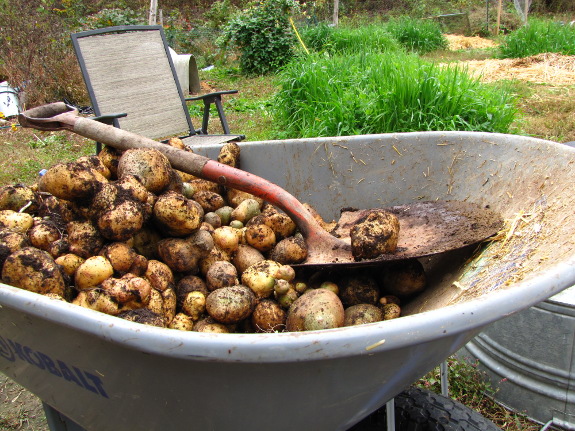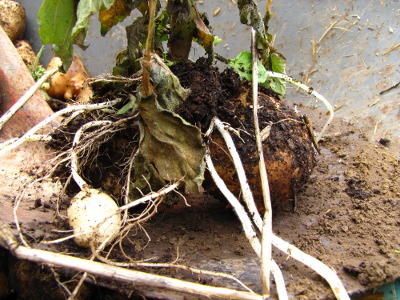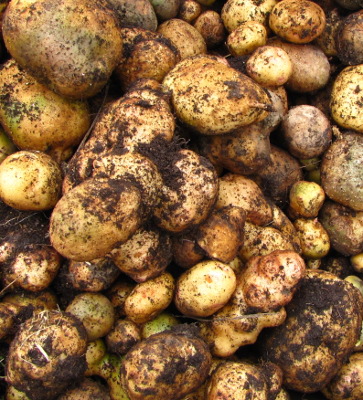
Late planted potato experiment

We had an odd potato
harvest this year. Although I planted a few pounds at the normal
March date, I saved most of my seed potatoes to go in the ground at the
beginning of May. A friend had told me that he waits to plant his
potatoes until after the frost free date, which gives him full size
tubers late enough in the year that he can dig them in cool
weather. We rarely want potatoes in the summer, so I figured a
fall crop of potatoes sounded good and followed his lead.
At first, the experiment
seemed to be paying off in spades. A third or more of our early
planted potatoes often rot in the cold soil before they start growing,
but my May-planted beds were chock full of potatoes. The plants
grew like crazy...but they wouldn't die. For those of you who
haven't grown potatoes, you want to wait to harvest your main crop
until the plants die back, which means they've hardened up the skins of
the tubers and given the spuds longevity to last through the winter in
your root cellar. So, potatoes that don't die are a problem ---
you can dig new
potatoes, but not
storage potatoes.
 When our first hard frost
came, the last plants started to wither, so I went ahead and dug our
potatoes. My underground adventure confirmed my hypothesis ---
the potatoes produced in May and June had sprouted up new plants in
July and August and started putting out a second round of tubers in
September and October. This sounds good --- double potatoes ---
but is actually problematic. Some of the older tubers had rotted
after giving their strength to the new growth, and I hadn't thought to
hill up the second round of potatoes (who hills their potatoes in
August?!), so most of them were green on one side.
When our first hard frost
came, the last plants started to wither, so I went ahead and dug our
potatoes. My underground adventure confirmed my hypothesis ---
the potatoes produced in May and June had sprouted up new plants in
July and August and started putting out a second round of tubers in
September and October. This sounds good --- double potatoes ---
but is actually problematic. Some of the older tubers had rotted
after giving their strength to the new growth, and I hadn't thought to
hill up the second round of potatoes (who hills their potatoes in
August?!), so most of them were green on one side.
Here is the yield from
the 6 pounds of potatoes I planted late:
- 10 pounds of wounded potatoes (some injured by the spade, others just troubled)
- 30 pounds of partly green potatoes
- 49 pounds of good potatoes
 Now, to be fair, this is an
awesome yield --- 15 times as many pounds of potatoes as I put in the
ground! Even if you just look at the good potatoes, the
experiment paid off since one pound of seed potatoes turned into 8
pounds of good potatoes (versus the 6.5 pounds of good potatoes I got
in previous years.)
Now, to be fair, this is an
awesome yield --- 15 times as many pounds of potatoes as I put in the
ground! Even if you just look at the good potatoes, the
experiment paid off since one pound of seed potatoes turned into 8
pounds of good potatoes (versus the 6.5 pounds of good potatoes I got
in previous years.)
What I'm not sure about
is how long the good potatoes will last. Several of the biggest
ones have hollow heart (which is a disorder characterized by exactly
what the name suggests), perhaps because I hilled them up the first
time with manure. And the second round of potatoes might not have
enjoyed enough growing time to harden off for storage. And, of
course, there's the problem that I'll have to cut all that green off
the problematic potatoes.
So, interesting
experiment, but I'm not sure if I'll repeat it. Has anyone else
had experience with planting potatoes late?
Want more in-depth information? Browse through our books.
Or explore more posts by date or by subject.
About us: Anna Hess and Mark Hamilton spent over a decade living self-sufficiently in the mountains of Virginia before moving north to start over from scratch in the foothills of Ohio. They've experimented with permaculture, no-till gardening, trailersteading, home-based microbusinesses and much more, writing about their adventures in both blogs and books.
Want to be notified when new comments are posted on this page? Click on the RSS button after you add a comment to subscribe to the comment feed, or simply check the box beside "email replies to me" while writing your comment.

Potatoes are from the nightshades family. These plants commonly contain glycoalkaloids, which are poisonous.
In potatoes, exposure to light tends to increase the concentration of glycoalkaloids in the tubers. It also causes them to green because of chlorophyll synthesis. So the greening itself isn't the cause of potatoes becoming more toxic.
Daddy --- I tried to pull out the really young potatoes to eat soon, but am hoping that the others will harden up as they cure. Not sure about burying potatoes to take away the green, though --- I've never heard that potatoes can go back once they turn green. You'd think that if they could, just putting them in a dark place would suffice.
J --- The green contains solanine, which is a nerve toxin. (Well, it also contains chlorophyll, which is what makes it green, but that's harmless.) I've read that you have to eat about 4 pounds of green potatoes to get really sick, but still...
I'm pretty sure the big growers hill their potatoes, probably with some attachment on the back of a tractor that pulls dirt up as the plants grow.
Eric --- A bit further south than us, people grow fall potatoes using the schedule you mentioned. I think we're just a bit too cold for potatoes to reliably get ready before frost if you plant them in late summer. It's possible that our potatoes got confused by the wet early summer, though, and thought they were on the fall track, not the spring track....
Potatoes have been part of our staple diet here in the Netherlands for hundreds of years. (See e.g. van Gogh's the potato eaters) So I was taught as a child that the green parts were dangerous. Of course I looked up why that was in our encyclopedia. (Yes, it was that long ago. )
)
When biking I sometimes pass through Nuenen, the place where van Gogh lived when he painted the potato eaters. Of course it's much bigger now than it was in his time.
As far as I know, he painted real people in that picture, and the clothes and house interior match the period. It is an interesting window in time.
Anonymous --- Thanks for the first hand information! I had a feeling I might be able to cut the tops back if I had to, but wasn't sure. Glad to hear that's a possibility.
Fritz --- If you don't try crazy things the way I did, growing potatoes is very easy. I'm sure you'll have good luck with it.